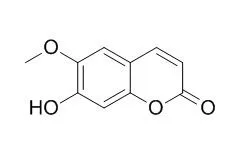| Description: |
Scopoletin exhibits antifungal, anti-allergic, anti-aging,
and hypouricemic activities, it exerts anti-RA action probably through suppressing IL-6 production from fibroblast-like synoviocytes via MAPK/PKC/CREB pathways. Scopoletin can ameliorate alcohol-induced hepatic lipid accumulation by modulating AMPK-SREBP pathway-mediated lipogenesis in mice fed a high-fat diet. |
| Targets: |
AMPK | p53 | IL Receptor | PKC | AChR | P450 (e.g. CYP17) | SOD | ERK | cAMP | p38MAPK | HDAC | Nrf2 | IFN-γ | NF-kB | TNF-α | IkB | AChR | IKK |
| In vitro: |
| J Exp Bot. 2014 Aug;65(15):4305-15. | | Scopoletin is a phytoalexin against Alternaria alternata in wild tobacco dependent on jasmonate signalling.[Pubmed: 24821958] | Alternaria alternata (tobacco pathotype) is a necrotrophic fungus causing severe losses in Nicotiana species by infection of mature leaves. Similar to what has been observed in cultivated tobacco, N. tabacum, young leaves of wild tobacco, N. attenuata, were more resistant to A. alternata than mature leaves, and this was correlated with stronger blue fluorescence induced after infection. However, the nature of the fluorescence-emitting compound, its role in defence, and its regulation were not clear.
METHODS AND RESULTS:
Silencing feruloyl-CoA 6'-hydroxylase 1 (F6'H1), the gene encoding the key enzyme for Scopoletin biosynthesis, by virus-induced gene silencing (VIGS) revealed that the blue fluorescence was mainly emitted by Scopoletin and its β-glycoside form, scopolin. Further analysis showed that Scopoletin exhibited strong antifungal activity against A. alternata in vitro and in vivo. Importantly, jasmonic acid (JA) levels were highly elicited in young leaves but much less in mature leaves after infection; and fungus-elicited Scopoletin was absent in JA-deficient plants, but was largely restored with methyl jasmonate treatments. Consistent with this, plants strongly impaired in JA biosynthesis and perception were highly susceptible to A. alternata in the same way Scopoletin/scopolin-depleted VIGS F6'H1 plants. Furthermore, silencing MYC2, a master regulator of most JA responses, reduced A. alternata-induced NaF6'H1 transcripts and Scopoletin.
CONCLUSIONS:
Thus, it is concluded that JA signalling is activated in N. attenuata leaves after infection, which subsequently regulates Scopoletin biosynthesis for the defence against A. alternata partly through MYC2, and higher levels of Scopoletin accumulated in young leaves account for their strong resistance. | | Phytomedicine. 2015 Mar 15;22(3):362-8. | | Scopoletin has a potential activity for anti-aging via autophagy in human lung fibroblasts.[Pubmed: 25837273] | Autophagy was known to be associated with aging in addition to cancer and neurodegeneration. The effects of Scopoletin on autophagy and anti-aging were investigated in human lung fibroblast cell line, IMR 90.
METHODS AND RESULTS:
Here we show that Scopoletin induces autophagy. It is also identified that the modulation of p53 by Scopoletin are related to the induction of autophagy. Moreover, the level of SA-β-Gal staining, an aging marker, is reduced by Scopoletin. In addition, while the expression levels of histone deacetylases such as HDAC1, SIRT1 and SIRT6 are increased in IMR 90 cells in the presence of Scopoletin, the expression levels of histone acetyltransferases are decreased. Furthermore, Scopoletin enhances the level of transcription factors such as Nrf-2and p-FoxO1 related to anti-aging. In addition, Scopoletin modulates the reprogramming proteins.
CONCLUSIONS:
Therefore, these findings suggest that Scopoletin could exert a positive effect on anti-aging related to autophagy through modulation of p53 in human lung fibroblasts. |
|
| In vivo: |
| Metabolism. 2014 Apr;63(4):593-601. | | Scopoletin prevents alcohol-induced hepatic lipid accumulation by modulating the AMPK-SREBP pathway in diet-induced obese mice.[Pubmed: 24559844] | This study investigated the effects of Scopoletin on alcohol-induced hepatic lipid accumulation in diet-induced obese mice and its mechanism.
METHODS AND RESULTS:
Alcohol (25% v/v, 5g/kg body weight) was orally administered once a day for 6 weeks to mice fed with a high-fat diet (35%kcal) with or without Scopoletin (0.05%, wt/wt).
Scopoletin reduced plasma acetaldehyde, fatty acid, total cholesterol, triglyceride and insulin levels, hepatic lipid and droplets and fasting blood glucose levels that were increased by alcohol. Scopoletin significantly activated hepatic AMPK and inhibited ACC and SREBP-1c and the activities of lipogenic enzymes, such as FAS, PAP and G6PD compared to the alcohol control group. Moreover, Scopoletin significantly inhibited hepatic CYP2E1 activity and protein levels but elevated the activities of SOD, CAT, GSH-Px and GST and the levels of GSH compared to the alcohol control group. The hepatic lipid peroxide level was significantly lowered by Scopoletin supplementation in alcohol-administered obese mice.
CONCLUSIONS:
Taken together, these results suggested that Scopoletin can ameliorate alcohol-induced hepatic lipid accumulation by modulating AMPK-SREBP pathway-mediated lipogenesis in mice fed a high-fat diet. | | J Med Chem. 2004 Dec 2;47(25):6248-54. | | Acetylcholinesterase inhibitory activity of scopolin and scopoletin discovered by virtual screening of natural products.[Pubmed: 15566295 ] |
METHODS AND RESULTS:
Scopoletin exhibited an immediate and dose-dependent hypouricemic effect after intraperitoneal administration (50, 100, 200 mg/kg) in hyperuricemic mice induced by potassium oxonate; however, it did not affect the serum uric acid level in normal mice at the tested doses. For exploring the involved mechanisms of action of Scopoletin, potential inhibitory effects on xanthine oxidase and possible uricosuric effects were investigated. Scopoletin (50, 100, 200 mg/kg) significantly inhibited the activity of xanthine oxidase in liver homogenates of hyperuricemic mice although it only showed a relatively weak, albeit competitive-type, inhibition of xanthine oxidase in a commercial assay. Furthermore, a potent uricosuric effect of Scopoletin (100, 200 mg/kg) was ascertained.
CONCLUSIONS:
These results demonstrated for the first time that Scopoletin exhibits, hypouricemic activities through decreasing uric acid production and as well as a uricosuric mechanism. |
|






 Cell. 2018 Jan 11;172(1-2):249-261.e12. doi: 10.1016/j.cell.2017.12.019.IF=36.216(2019)
Cell. 2018 Jan 11;172(1-2):249-261.e12. doi: 10.1016/j.cell.2017.12.019.IF=36.216(2019) Cell Metab. 2020 Mar 3;31(3):534-548.e5. doi: 10.1016/j.cmet.2020.01.002.IF=22.415(2019)
Cell Metab. 2020 Mar 3;31(3):534-548.e5. doi: 10.1016/j.cmet.2020.01.002.IF=22.415(2019) Mol Cell. 2017 Nov 16;68(4):673-685.e6. doi: 10.1016/j.molcel.2017.10.022.IF=14.548(2019)
Mol Cell. 2017 Nov 16;68(4):673-685.e6. doi: 10.1016/j.molcel.2017.10.022.IF=14.548(2019)